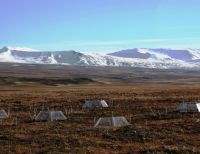He is world-renowned for coming off as significantly younger than his actual age. A few thousand years younger, more or less. Indeed, those who came across Tollund Man while digging for peat in Bjældskovdal bog in 1950 suspected him to be a recent murder victim.
That was because Tollund Man – like other so-called bog bodies – was found in a wetland. Submerged in the nutrient poor bog, his body was quickly and continuously immersed in an environment free of oxygen, the presence of which is a prerequisite for the decomposition of anything organic – corpses included.
Facts: What is a wetland?
There are many types of wetlands around the world. The term encompasses wet areas where water is located either just above or below the soil surface.There are both fresh and saltwater wetlands. In Denmark, the best examples are bogs and marshes, but mangrove forests and tropical swamps are also examples of wetlands.
Major differences exist between wetlands. For example, in Vietnam, researchers expect to find wetlands that emit more greenhouse gases than they absorb – specifically in connection with rice paddies.
This is precisely what makes wetlands one of the most powerful natural means for us to use to prevent climate change. It is a fact that has gradually dawned upon researchers and decision-makers in recent years – and will be celebrated today, February 2nd, on World Wetlands Day, along with the important role that wetlands play in relation to preserving nature and biodiversity.
Over the next six years, the recently opened Global Wetland Center at the University of Copenhagen’s Department of Geosciences and Natural Resource Management will investigate and map the potential of wetlands and their local variations with the help of a DKK 60 million grant from the Novo Nordisk Foundation. The studies will be conducted in collaboration with the Department of Computer Science (UCPH), GEUS and DHI.
"While local variations need to be investigated, we already know that the conservation of natural wetlands overall provides a significant net gain for the greenhouse gas budget. Under the right conditions, they are able to absorb CO2 and store it beneath shields of water that can indefinitely prevent its decomposition – just like Tollund Man and Grauballe Man. Had they been buried in oxygen-rich locations, we would have never known about them," says Associate Professor Guy Schurgers from the Department of Geosciences and Natural Resource Management, who heads the new center.
Unique CO2 uptake, with a noteworthy exception
Just as in a forest, wetland trees and plants absorb CO2 from the atmosphere. But whereas vegetation on a forest floor decomposes, plants that fall into wetlands become submerged.
"After a number of years, forests end up in an equilibrium due to decomposition, as CO2 absorption and emissions balance to zero. Wetlands do not. Due to the water's ability to shut off oxygen from the atmosphere, the areas are unique in their ability to continue pulling CO2 from the atmosphere," explains Guy Schurgers.
This also means that wetlands store many years’ worth of carbon removal. For example, while peat bogs make up only about 3% of the Earth's landmass, they store twice as much carbon as all of the world's forests combined.
However, there is a negative in the budget that demands further examination: methane and nitrous oxide.
"Globally, we know that, as a whole, these areas are the most efficient way to extract CO2 from the atmosphere and maintain it naturally. However, one also finds local wetlands where the greenhouse gas budget is negative. This is partly because, due to the lack of oxygen, wetlands have a negative by-product in the form of methane production. Even though it is produced in small quantities, methane is a potent greenhouse gas and it is important that we investigate this mechanism in depth," he says.
In nitrogen-rich areas, oxygen-poor conditions can also contribute to the production of nitrous oxide – another important greenhouse gas. This can occur in fertilised rice paddies or wetlands which receive nitrogen from nearby farms.
As such, one of the center's main tasks will be to gather local knowledge about wetlands around the world.
Experiments must find local differences and solutions
Wetlands are far from uniform. Because of their diversity, Guy Schurgers explains that it is essential for the Global Wetland Center to develop models for studying the phenomenon. These models need to be able to account for local differences – such as the role of water tables in the tropics versus the tundra and on the coast or inland – as well as being able to detect commonalities across the differences.
Experiments in three countries
The researchers will conduct experiments in various wetlands in Vietnam, Tanzania and Norway so as to investigate local differences with a major focus on two types of consequences:
- How do wetlands – and changes in their environmental conditions – affect the greenhouse gas budget for the emissions and removal of carbon dioxide (CO2), methane (CH4) and nitrous oxide (N2O)?
- What are the consequences for populations in each area? For example, how does the status quo or a particular management solution impact harvests?
"Once the models can distinguish correctly, we hope they’ll be able to be used to map the global extent of wetlands and give us a better idea of exactly what these areas mean for our planet's climate with the help of satellite imagery. Today’s increased resolutions offer opportunities that didn’t exist five years ago," says Guy Schurgers.
But to make doing so possible, studying wetlands from above is insufficient – scientists will need to get their feet on the ground. Because in many places, their understanding of wetlands is very limited. This is particularly true for the less well-studied wetlands beyond Europe and North America.
As such, the center will conduct case studies with actual experiments in wetlands, initially in Vietnam, Tanzania and Norway.
An important aspect of the center's agenda is for the results to not end up stranded on a university shelf, but for them to be useful and rapidly passed along to decision-makers. This is also one of the reasons why the project focuses on case-study experiments.
"Field studies will allow us to obtain experiment results that are ready to be applied in practice. Therefore, we will also be certain to incorporate local considerations into the design, so that our discoveries can actually be used by agencies and not end up as theoretical exercises," concludes the researcher.
An interdisciplinary dream team
The center, which opened 1 January, gathers professionals from diverse backgrounds who haven't worked together on the same scale before. Guy Schurgers describes the center's assembly of geographers, computer scientists and engineers as an interdisciplinary "dream team" that will take research to new levels.
- Experimenters will study the biogeochemical mechanisms of the exchange of carbon as greenhouse gases (CO2, CH4, N2O) and the different ways they play out in various types of wetlands.
- Modelers will translate this knowledge into biogeochemical and hydrological models that can be used to understand the mechanisms on a larger scale.
- Using satellite images, Earth Observation specialists will provide knowledge about the extent of and changes to wetlands over time.
- Computer scientists from UCPH’s Department of Computer Science (DIKU) will use AI tools to extend the analyses and models up to a global scale.
- Skilled practitioners must develop implementable methods to improve wetlands and make the new knowledge understandable and usable for decision-makers.
- As collaborative partners with the Global Wetland Center, GEUS, contributing with hydrological field and modelling expertise, and DHI, contributing with expertise on Earth observation and modelling and as Danish link to the UN's environmental organization, UNEP, participate in the project.
The opening of Global Wetland Center
The Global Wetland Center officially opened at the beginning of the year and its work has long since begun. Keep up with the center's activities on their website: www.globalwetlandcenter.ku.dk
In conjunction with World Wetlands Day, an opening celebration with presentations about the center's activities will be held on Friday 2/2 at 2pm. The event is open to all and may be registered for by writing to Center Administrator Tania Nielsen at [email protected].














